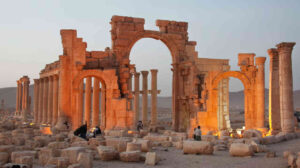Os lugares antigos danificados e destruídos pelo Isis
A chocante destruição da cidade síria de Palmira faz parte da campanha do grupo contra a arqueologia.
Por Andrew Curry – National Geographic: 1 de setembro de 2015
O Estado Islâmico continua a guerra contra a herança cultural da região do Iraque e da Síria, atacando sítios arqueológicos com escavadeiras e explosivos.
O Isis divulgou um vídeo que chocou o mundo no mês passado ao mostrar a impetuosa destruição do Templo de Baalshamin, uma das ruínas melhor preservadas em Palmira, na Síria. No final de semana passado, explosões foram registradas em outro templo de Palmira, dedicado ao antigo deus Baal; uma agência da ONU diz que imagens de satélite mostram que o templo maior foi em grande parte destruído.
A destruição é parte da campanha de propaganda que inclui vídeos de militantes e a colocação de explosivos em santuários cristãos e muçulmanos de séculos de idade.
O Isis controla grandes extensões da Síria, junto com o norte e o oeste do Iraque. Há pouco que impeça seus militantes de saquear e destruir lugares sob seu controle em uma região conhecida como o berço da civilização.
O grupo militante é apenas mais uma de muitas facções lutando pelo controle da Síria, onde uma guerra civil deixou mais de 230.000 mortos e milhões de desabrigados.
O grupo alega que a destruição de locais antigos tem motivação religiosa; os alvos dos militantes são lugares antigos conhecidos e túmulos modernos e santuários pertencentes a outras seitas muçulmanas, citando o culto de ídolos para justificar suas ações. Ao mesmo tempo, o Isis tem usado o dinheiro roubado como fonte de renda para financiar suas operações militares.
“É tão propagandista quanto sincero”, afirma Christopher Jones, historiador da Universidade de Columbia, que relatou os danos em seu blog. “Eles se veem recapitulando a história antiga do Islã.”
Um guia dos locais culturais que o ISIS danificou até agora:
SÍRIA
Palmira
Palmira prosperou durante séculos no deserto ao leste de Damasco, como um oásis e ponto de parada para caravanas na Rota da Seda. Parte do Império Romano, era uma próspera e rica metrópole. A cidade-estado atingiu o ápice no final do século III, quando foi governada pela Rainha Zenóbia e se rebelou brevemente contra Roma.
Zenóbia falhou, e Palmira foi reconquistada e destruída pelos exércitos romanos em 273 d.C. As avenidas colunadas e templos impressionantes foram preservados pelo clima do deserto e no século 20 a cidade se tornou um dos maiores destinos turísticos da Síria.
O Isis conquistou a Palmira moderna e as antigas ruínas em maio de 2015. Inicialmente, os militantes prometeram deixar as colunas e templos intocados. Mas as promessas foram em vão: em agosto, eles publicamente executaram Khaled al-Asaad, um arqueólogo sírio que supervisionou escavações no local por décadas, e penduraram seu corpo decapitado em uma coluna.
E no mês passado o grupo divulgou fotos de militantes destruindo o Templo de Baal Shamin, de 1,9 mil anos, com explosivos. Um dos edifícios melhor preservados de Palmira, foi originalmente dedicado a um deus fenício das tempestades. Agora não resta nada além de escombros.
Mosteiro de Mar Elian
O mosteiro cristão foi tomado em agosto, quando militantes do Isis capturaram a cidade síria de Al-Qaryatain, perto de Palmira. Dedicado a um santo do século IV, o templo era um importante local de peregrinação e abrigou centenas de sírios cristãos. Testemunhas dizem que tratores foram usados para derrubar as paredes. O Isis publicou fotos da destruição no Twitter.
Apameia
Uma rica cidade comercial da era romana, Apameia foi saqueada desde o começo da guerra civil na Síria, antes mesmo do Isis aparecer. Imagens de satélite mostram dezenas de covas feitas no local; mosaicos romanos desconhecidos até então foram escavados e removidos para venda. Acredita-se que o Isis recolha uma parcela do valor das vendas de antigos artefatos, faturando milhões de dólares para financiar suas operações.
Dura-Europos
Assentamento grego no rio Eufrates, não muito longe da fronteira da Síria com o Iraque, Dura-Europos mais tarde se tornou um dos postos mais orientais de Roma. Abrigava a igreja cristã mais antiga do mundo, uma sinagoga belamente decorada e muitos outros templos e construções da era romana. Imagens de satélite mostram uma paisagem de crateras entre os muros de lama e tijolos da cidade, prova do aumento da destruição dos saqueadores.
Mari
Mari floresceu na Idade do Bronze, entre 3.000 e 1.600 a.C. Arqueólogos descobriram palácios, templos e extensos arquivos escritos em argila que trouxeram nova luz para os primeiros dias da civilização na região. De acordo com relatos de locais e imagens de satélite, o lugar, especialmente o palácio real, está sendo saqueado sistematicamente.
IRAQUE
Hatra
Construída no terceiro século a.C., Hatra era a capital de um reino independente à margem do Império Romano. A combinação de arquitetura influenciada pelos gregos e pelos romanos, com características do ocidente, são provas da sua proeminência como importante centro comercial da Rota da Seda. Hatra foi nomeada Patrimônio Mundial da Unesco em 1985.
Em 2014, Hatra foi tomada pelo Isis e supostamente usada como depósito de munição e campo de treinamento. Um vídeo divulgado pelo grupo em abril de 2015 mostra combatentes usando marretas e armas automáticas para destruir esculturas em várias construções do local. “A destruição de Hatra marca um momento crítico na terrível estratégia de limpeza cultural em curso no Iraque”, afirmou na época Irina Bokova, diretora geral da Unesco.
Nínive
A antiga Assíria foi um dos primeiros verdadeiros impérios, expandindo-se agressivamente por todo o Oriente Médio e controlando uma vasta área do mundo antigo entre 900 e 600 a.C. Os reis assírios governavam a partir de uma série de capitais onde hoje é o norte do Iraque. Nínive era uma delas, florescendo sob o comando do imperador assírio Sennacherib por volta do ano 700 a.C. Em um certo momento, Nínive foi a maior cidade do mundo.
Localizada no entorno de Mossul – parte da cidade moderna foi construída sobre as ruínas de Nínive – colocou o local na mira do Isis quando o grupo tomou a cidade em 2014. Muitas das esculturas foram abrigadas no Museu de Mossul (veja no próximo tópico) e algumas foram danificadas durante o tumulto no museu, documentado em vídeo. Os homens também foram mostrados esmagando estátuas de guardiões que são metade humanos e metade animais, chamados lamassus, no antigo Nirgal Gate de Nínive. “Eu não tenho certeza se ainda há muito para ser destruído em Mossul”, diz Jones, da Universidade de Columbia.
Museu e bibliotecas de Mossul
Relatos de roubos a bibliotecas e universidades de Mossul começaram a surgir assim que o Isis ocupou a cidade. Manuscritos de centenas de anos foram roubados e milhares de livros desapareceram no sombrio mercado internacional de arte. A biblioteca da Universidade de Mossul foi incendiada em dezembro de 2014. No final de fevereiro de 2015, a campanha do Isis cresceu: a biblioteca pública central de Mossul, um marco construído em 1921, foi destruída por explosivos junto com milhares de manuscritos e instrumentos utilizados por cientistas árabes.
O incêndio dos livros coincidiu com a divulgação do vídeo mostrando combatentes do Isis em um alvoroço no Museu de Mossul, derrubando estátuas e destruindo outras com martelos. O museu era o segundo maior do país, atrás apenas do Museu do Iraque em Bagdá. As estátuas incluíam obras-primas de Hatra e Nínive.
Margarete van Ess, chefe do escritório no Iraque do Instituto Arqueológico Alemão, afirma que um olho treinado é capaz de dizer que pelo menos metade dos artefatos destruídos no vídeo são cópias; muitos dos originais estão no Museu do Iraque.
Nimrud
Nimrud foi a primeira capital assíria, fundada há 3.200 anos. Sua rica decoração refletia o poder e a riqueza do império. O local foi escavado no começo dos anos 1840 por arqueólogos britânicos, que mandaram dezenas de suas gigantescas esculturas de pedra para museus de todo o mundo, incluindo o Metropolitan Museum of Art em Nova Iorque e o British Museum em Londres. Muitos originais permaneceram no Iraque.
O local em si é gigante: uma muralha de terra envolve uma área de 360 hectares. O Ministério de Turismo e Antiguidades do Iraque diz que o Isis destruiu partes do local, mas a extensão dos danos ainda não está clara. Parte da cidade nunca foi descoberta e permanece debaixo da terra – protegida, é de se esperar.
Khorsabad
Khorsabad é outra antiga capital da Assíria, a poucos quilômetros de Mossul. Seu palácio foi construído entre 717 e 706 a.C pelo Rei Sargão II da Assíria. Suas esculturas em relevo e estátuas estavam notavelmente bem preservadas, com traços da tinta original ainda decorando as representações das vitórias assírias e das procissões reais.
A maior parte das esculturas e muitas das estátuas foram removidas durante escavações francesas no meio dos anos 1800 e por equipes do Instituto Oriental de Chicago nas décadas de 1920 e 1930. Agora estão no Museu do Iraque de Bagdá, em Chicago e no Louvre, em Paris. Não está muito claro qual parte do local era alvo do Isis.
“Nós não temos fotografias mostrando até onde os danos podem chegar”, afirma van Ess. “A única informação agora vem de pessoas locais e do Ministério de Antiguidades do Iraque.”
Mosteiro dos Mártires São Behnam e sua irmã Sarah
Estabelecido no século IV, o mosteiro era dedicado a um antigo santo cristão. O local sagrado, mantido desde o final dos anos 1800 pelos monges sírios católicos, sobreviveu às hordas mongóis nos anos 1200 mas caiu nas mãos do Isis em março. Os extremistas usaram explosivos para destruir o túmulo do santo e suas elaboradas esculturas e decorações.
Mesquita do Profeta Jonas
A Mesquita do Profeta Jonas de Mossul era dedicada à figura bíblica, considerado um profeta por muitos muçulmanos. Mas o Isis é adepto de uma interpretação extrema do Islã que enxerga a veneração de profetas como Jonas como algo proibido. Em 24 de julho de 2015, combatentes do ISIS evacuaram a mesquita e a demoliram com explosivos.
Como muitos lugares do Iraque, a mesquita era uma camada da história, construída em cima de uma igreja cristã que, por sua vez, foi construída em cima de dois montes que compunham a cidade assíria de Nínive.
O Mausoléu de Imam Dur
O Mausoléu de Imam Dur, não muito longe da cidade de Samarra, era um exemplo magnífico de decoração e arquitetura medieval islâmica. Foi explodido em outubro.
Here Are the Ancient Sites ISIS Has Damaged and Destroyed – By Andrew Curry – National Geographic: September 1, 2015
Shocking destruction in the Syrian city of Palmyra is part of the militant group’s ongoing campaign against archaeology.
Islamist militants in Iraq and Syria continue their war on the region’s cultural heritage, attacking archaeological sites with bulldozers and explosives.
The so-called Islamic State (ISIS) released a video that shocked the world last month by showing the fiery destruction of the Temple of Baalshamin, one of the best-preserved ruins at the Syrian site of Palmyra. Last weekend, explosions were reported at another Palmyra temple, dedicated to the ancient god Baal; a United Nation agency says satellite images show that larger temple has largely been destroyed.
The destruction is part of a propaganda campaign that includes videos of militants rampaging through Iraq’s Mosul Museum with pickaxes and sledgehammers, and the dynamiting of centuries-old Christian and Muslim shrines.
ISIS controls large stretches of Syria, along with northern and western Iraq. There’s little to stop its militants from plundering and destroying sites under their control in a region known as the cradle of civilization.
The militant group is just one of many factions fighting for control of Syria, where a civil war has left more than 230,000 dead and millions more homeless.
The group claims the destruction of ancient sites is religiously motivated; Its militants have targeted well-known ancient sites along with more modern graves and shrines belonging to other Muslim sects, citing idol worship to justify their actions. At the same time, ISIS has used looting as a moneymaking venture to finance military operations.
“It’s both propagandistic and sincere,” says Columbia University historian Christopher Jones, who has chronicled the damage on his blog. “They see themselves as recapitulating the early history of Islam.”
A guide to cultural sites that ISIS has damaged or destroyed so far: (continue)
Síria vive nova escalada do conflito com Isil recuperando força – Nações Unidas: 27 Março 2024
O conflito, que se prolonga por mais de 13 anos, se transformou em uma “guerra por procuração” envolvendo várias potências estrangeiras e apesar de raramente chegar às manchetes, continua tendo um efeito terrível sobre a população civil.
No início de março, a Comissão de Inquérito das Nações Unidas sobre a Síria divulgou um relatório que detalha uma escalada nos combates, ataques a civis e infraestruturas que poderiam constituir crimes de guerra.
O vice-diretor e membro sênior do Centro de Cooperação Internacional da Universidade de Nova Iorque, Hanny Megally, é membro da Comissão desde 2017. Ele disse à ONU News que, embora já tenham se passado cinco anos desde a última vez que o Isil ocupou territórios na Síria, o grupo continua ganhando força.
Segundo ele, o país está “desmoronando” e alguns grupos que pareciam derrotados estão voltando, sem que nenhuma das “causas profundas” do conflito tenham sido tratadas. A Comissão aponta que o Isil vem aumentando sua força na Síria e, só este ano, já cometeu mais de 35 ataques.



